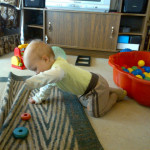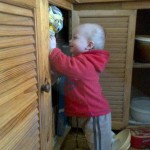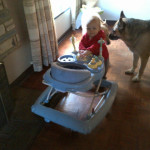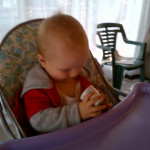Some of you may remember that I am a qualified Montessori teacher (at Pre-school level). However, I’ve been pretty slack when it comes to using all the skills that I should be. I haven’t given him the room with the mattress on the floor with the mirror. I haven’t been making materials for him to use. In short, another mom fail.
I subscribe to Deb Chitwood’s “Living Montessori Now” newsletter, and to be honest, I normally delete it as my child is not old enough to do the pre-school activities. However, Deb recently announced that she is to be a grandmother, and hence her sudden interest in all things baby.
She put together an interesting post of baby resources, and I’d like to share some of the interesting things I’ve gleamed from this.
- The Montessori philosophy of “follow the child” is pretty much what I have been doing all along, so I don’t need to feel so guilty for not “doing” much.
“Follow the child” is the mantra of the Montessori movement. The adults’ role is to create a stimulating environment and then leave the child undisturbed. One of the biggest mistakes parents make is to believe that children need to be entertained or engaged by an adult all or most of the time, it argues. The “most important thing a parent can do is nothing!” the guide advises. “Simply observe, without interrupting with conversation, questions, or offers of help,” it says.
(This is taken from a review by Sarah Cassidy of Kathie Hughes book Learning Together: What Montessori Can Offer Your Family,)
2. Given freedom of choice, children show more interest in real materials than toys. This is so true! Nicky loves to play with real objects.
 3. The room with the mattress on the floor is not so far removed from what I have. I do have a mattress on the floor for his daytime naps, but I have it surrounded with a playpen activity wall which he loves to play with. It also serves as a way to keep him in, but most of the time I leave it open. There is lots of stuff in the house within his reach. At the moment he is building up to walking so he loves to pull up to stand against something and play with objects that he can reach.
3. The room with the mattress on the floor is not so far removed from what I have. I do have a mattress on the floor for his daytime naps, but I have it surrounded with a playpen activity wall which he loves to play with. It also serves as a way to keep him in, but most of the time I leave it open. There is lots of stuff in the house within his reach. At the moment he is building up to walking so he loves to pull up to stand against something and play with objects that he can reach.
4. Creating a home that will be best for a Montessori infant mainly means baby proofing your home so they can get around as much as possible. Low shelves where they could reach things are great. Child size furniture is also a pretty common practice, and we will use this when Nicky gets bigger.
Due to the way the infant grows and craves movement (see this article), it is recommended that you allow movement (lying on back, front, then all fours…). We have done this. Bouncy chairs and other commercial movement devices restrict. I find it fascinating the way Nicky really doesn’t like to be put in his walker, but prefers to push it. It actually works better than the pushing toy we got him. This article was nice because it dealt with a 13 month old (close enough to Nicky) and it says that exploration is key. Moving around, going up and down stairs, unpacking cupboards….. yip, that sounds right!
6. The Montessori philosophy of choice lends itself to baby led weaning. Choosing food is just another extension of choosing activities. In this lovely article, the author shows us how she uses real stuff i.e. glass to get her baby to drink. I decided to try with Nicky with a little china cup. Yip, he is still pouring it out. I have so many different Sippy cups… Oh well we will bash on with whatever will work…
Child size furniture is advocated, and sitting on mom’s lap for a baby. In this post, the author says that the high chair worked better for her as baby was then part of the family table. I know Nicky only tolerates the high chair when there are people around. He definitely prefers my lap. But a lot of the time I am ashamed to say I have been feeding him as he crawls around on the floor. I am just doing whatever works.
 7. Deb has a lot of suggested toys, particularly mobiles. I liked this post which had lots of different ideas, such as finding objects, putting them in and out, sound discrimination and even matching shoes (what a neat idea!). One of the activities is stacking. Let me tell you what my unique kid did with our stacking rings. He took it apart and used the central stick like a bat to push another part along. That was much more fun! I have another variation of this (square shaped containers) in the bath which he enjoys putting together. We have also done crushing paper numerous times with various papers! We love not just opening and closing objects but opening and shutting doors. We even have a song for this that we learnt at baby bible class. (Open shut them, open shut them, give a little clap, clap, clap! Open shut them, open shut them, put them in your lap, lap, lap! Creep them, creep them. creep them, creep them right up to your chin, chin, chin! Open up your little mouth and put your biscuit in!)
7. Deb has a lot of suggested toys, particularly mobiles. I liked this post which had lots of different ideas, such as finding objects, putting them in and out, sound discrimination and even matching shoes (what a neat idea!). One of the activities is stacking. Let me tell you what my unique kid did with our stacking rings. He took it apart and used the central stick like a bat to push another part along. That was much more fun! I have another variation of this (square shaped containers) in the bath which he enjoys putting together. We have also done crushing paper numerous times with various papers! We love not just opening and closing objects but opening and shutting doors. We even have a song for this that we learnt at baby bible class. (Open shut them, open shut them, give a little clap, clap, clap! Open shut them, open shut them, put them in your lap, lap, lap! Creep them, creep them. creep them, creep them right up to your chin, chin, chin! Open up your little mouth and put your biscuit in!)
8. Probably most surprising of all my findings here was that Montessori actually supports principles of attachment parenting.
Here are some quotes from “The Absorbent Mind”, which was actually one of my text books for the course that I did.
Let us think, for a moment, of the many peoples of the world who live at different cultural levels from our own. In the matter of child rearing, almost all of these seem to be more enlightened than ourselves – with all our Western ultramodern ideals. Nowhere else, in fact, do we find children treated in a fashion so opposed to their natural needs. In almost all countries, the baby accompanies his mother wherever she goes. Mother and child are inseparable . . . . And this lasts for the whole period of maternal feeding, which is the reason for this close alliance. For the mother has to feed her child, and therefore she cannot leave him at home when she goes out. To this need for food is added their mutual fondness and love . . . . Mother and child are one.
Except where civilization has broken down this custom, no mother ever entrusts her child to someone else. The child shares the mother’s life and is always listening.”
Interesting thoughts on baby wearing:
All the great human groups, nations and races, have their individual differences; for example, they have different ways of carrying the baby . . . . In most parts of the world, mothers put the baby on a small bed, or in a large bag; they do not carry him in their arms . . . . Some hang the child from their necks, others tie him to their backs, and others again put him in a small basket; but in all countries mothers have found a way of taking their children about with them.
One observes, too, that the little one, going about with his mother, never cries unless he is ill or hurt in some way. Sometimes he may fall asleep, but he does not cry.
Yet the crying of children is a problem in Western countries. How often do we hear parents complain of their children’s incessant crying? They discuss what to do to quieten the baby, and how to keep him happy. The reply of modern psychology is this: “The baby cries and becomes disturbed, has screaming fits and rages, because he is suffering from mental hunger.” And this is the truth. The child is bored. He is being mentally starved, kept prisoner in a confined space offering nothing but frustration to the exercise of his powers. The only remedy is to release him from solitude and let him join in social life. This treatment is naturally and unconsciously adopted in many countries. With us, it must become understood and applied deliberately, as a result of conscious thought.
It’s such a nice confirmation of my decisions to stay as close to Nicky as possible and carry him around too. (Although he also likes to crawl around a lot too, I think it’s all about balance…)
9. There is so much here but I just want to add one more thing from this brilliant post: “Stop Doing Montessori, Start Living Montessori” – that we get too caught up in the materials instead of going back to Montessori essentials.
She points out that we should be particularly aware of the sensitive periods so that we make sure these needs are being met.
I dug out my file and here is a run-down:
Sensitivity for Movement: Peaks 1-2, (from birth to death)
Language: Peaks at 2 (from 3months to 5 years)
Order: Peaks at 2 years (from a few months to 4 years)
Attention to Detail: Peaks at 2, (from 1-2)
Sensorial Impressions: Peaks at 3-5, (from brith-6)
Social Relationships: Peaks at 4 (from 2, 2 and a half to 5)
Soul, inner self: (birth to death)
As you can see, there’s quite a lot happening between 1-2 years, so I guess I will have my hands full, particularly with regards to movement!




Thanks so much for linking to my post, Heather! I’m happy to have discovered your blog! And thanks for sharing so many resources for babies! I pinned your post to my Babies – Activities and Ideas Pinterest Board. 🙂
Thanks for your excellent post which I used for this!
Love this — The “most important thing a parent can do is nothing!” the guide advises. So true in today’s world!
It sounds like you’re doing a great job with your little one!
Wow thank you. I have been thinking about how to incorporate Montessori for the baby as she gets older.. I love these ideas.
So many great resources! I love hearing about your Montessori experience – and how lucky is Nicky to be benefitting from it!
I never thought about Montessori as it would apply to a baby. Some interesting ideas.
I definitely need to get on top of baby proofing! Right now, the house is NOT ready for little miss to start getting around!
Don’t stress, ours isn’t totally either… but if you follow her around it helps. And get a taller dustbin and plug covers!!!
I’ve been meaning to take a look into the Montessori education but haven’t had a chance then I found your post. Thanks for the info. Certainly something I’m getting more interested in for my toddler.
I agree that self-directed play is most important for children. I don’t agree with planning out every minutes and every activity all day long. They need room to be creative.
I am happy to see that I am already doing a lot of these things! I have heard of Montessori but have never really looked into it. I can see now that my instinctual “methods” seem to match up a lot – I’m going to have to do more reading!
Yes, I think there’s a lot to be said for instinct. 🙂
Hi from ICLW,
Thanks for such a helpful post! I look forward to digging into the links you posted and learning more about Montessori! I’m an elementary teacher so I have to say I am a little familiar but I want to learn so much more! 🙂
Hello, from ICLW! I love the Montessori philosophy, and I so wish I had known more about it when my daughter was tiny. I will certainly do things differently next time… if I have a second child. Thanks for sharing!
Never heard of Montessori before. Or if I have, then it wasn’t called Montessori. After reading this post, it’s something I definitely want to check out!
Hello from ICLW. What a great post! I haven’t done anything ‘official’ Montessori-speaking, and some things that worked really well for our son were definitely not Montessori (crib + sleep sacks), but your post made me realize that quite a lot of what we did do was very similar to the Montessori philosophy, which I’m quite interested in. I do like the blog “How We Montessori”- I find she is full of great ideas of how to incorporate it into the home, and since her son is only a month older than mine, her posts are a great nudge sometimes when I need a little more confidence in letting E. do something himself.
Thank you, too, for the list of the sensitive periods. Learning that “Order” and “Attention to Detail” peak at age 2 has just made so many things make SO MUCH MORE sense.
Thank you for linking to so many great resources. Our son is 2 and has been in a Montessori program since 18 months. I have tried some Montessori approaches at home (hand washing station, child-sized furniture, baby-led weaning), but never did do the mattress on the floor. I found your blog through ICLW and am excited to read more.
Love this: “I am just doing whatever works.” <— YES! I am doing that, too. Sometimes that means snacks on the living room floor, because that's what works. I started out with lofty goals about having a schedule, doing certain activities, etc. and more and more I am just letting the day be what is, and doing what we (mom and baby both) have energy for. Often it is a lot less than I expected, but I am working on letting that be ok.
Thank you so much for all the great info in this post!
We follow the first step–but more often than not I feel guilty for NOT engaging him…but he plays so well by himself! Glad you posted this! It will help me not feel so guilty when he is playing w/an old telephone alone rather than a $20 toy from Fisher Price.